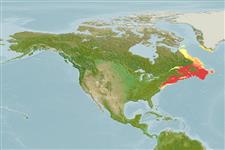Environment: milieu / climate zone / depth range / distribution range
Ökologie
seewasser; brackwasser demersal; ozeanodrom (Ref. 51243); tiefenbereich 0 - 388 m (Ref. 58426). Temperate; ? - 10°C (Ref. 35432); 63°N - 37°N, 80°W - 43°W
Northwest Atlantic: Labrador, Canada to Delaware, USA.
Length at first maturity / Size / Gewicht / Alter
Maturity: Lm 28.8 range ? - ? cm
Max length : 110 cm TL Männchen/unbestimmt; (Ref. 7251); max. veröff. Gewicht: 5.4 kg (Ref. 4926); max. veröff. Alter: 18 Jahre (Ref. 796)
Benthic; feeds on worms, crustaceans, molluscs, sea squirts, sea urchins and fishes (Ref. 58426).
Eggs are laid in gelatinous masses guarded by one or both parents until hatching (Ref. 35432). However, more recent evidence suggests that care is provided by the female alone (Ref. 104883).
Anderson, M.E., 1994. Systematics and osteology of the Zoarcidae (Teleostei: Perciformes). Ichthyol. Bull. J.L.B. Smith Inst. Ichthyol. 60:120 p. (Ref. 11954)
IUCN Rote Liste Status (Ref. 130435)
Bedrohung für Menschen
Harmless
Nutzung durch Menschen
Fischereien: kommerziell; Aquarium: Kommerziell
Mehr Information
PartnerBilderStamps, Coins Misc.LauteCiguateraGeschwindigkeitSchwimmstilKiemenoberflächeOtolithsGehirngrößeSehfähigkeit
Tools
Zusatzinformationen
Download XML
Internet Quellen
Estimates based on models
Preferred temperature (Ref.
123201): 0.4 - 9.5, mean 3 °C (based on 227 cells).
Phylogenetic diversity index (Ref.
82804): PD
50 = 0.5156 [Uniqueness, from 0.5 = low to 2.0 = high].
Bayesian length-weight: a=0.00186 (0.00120 - 0.00289), b=3.20 (3.07 - 3.33), in cm total length, based on LWR estimates for this species & (Sub)family-body (Ref.
93245).
Trophic level (Ref.
69278): 4.2 ±0.1 se; based on diet studies.
Generation time: 14.5 ( na - na) years. Estimated as median ln(3)/K based on 2
growth studies.
Widerstandsfähigkeit (Ref.
120179): niedrig, Verdopplung der Population dauert 4,5 - 14 Jahre. (K=0.08-0.11; tmax=18).
Fishing Vulnerability (Ref.
59153): High to very high vulnerability (67 of 100).
Climate Vulnerability (Ref.
125649): High to very high vulnerability (74 of 100).
Nutrients (Ref.
124155): Calcium = 21 [13, 34] mg/100g; Iron = 0.251 [0.157, 0.407] mg/100g; Protein = 18 [15, 20] %; Omega3 = 0.436 [0.268, 0.701] g/100g; Selenium = 21.5 [11.0, 41.1] μg/100g; VitaminA = 9.16 [3.35, 25.13] μg/100g; Zinc = 0.458 [0.342, 0.634] mg/100g (wet weight);
